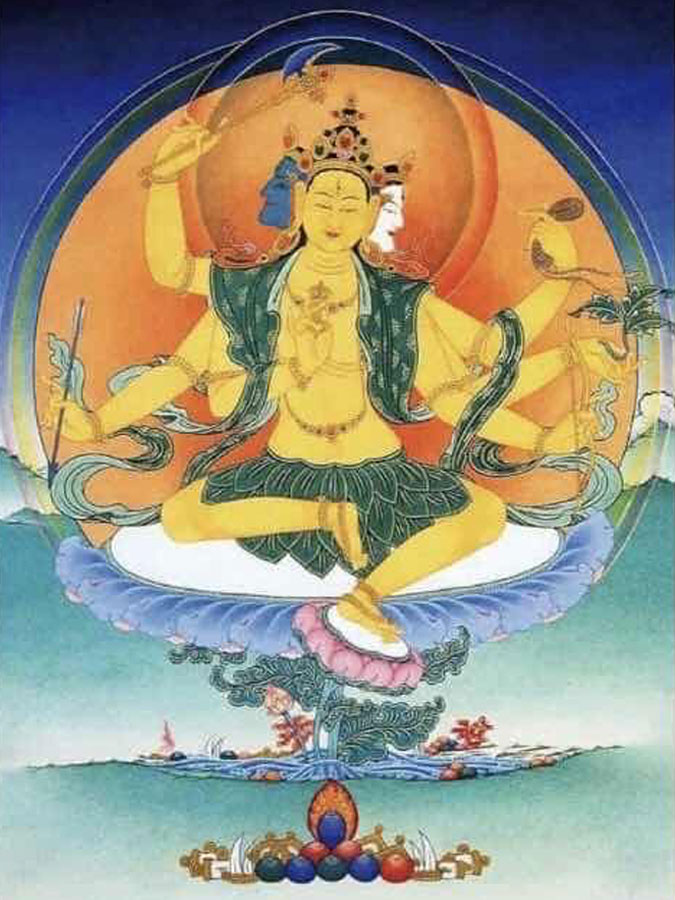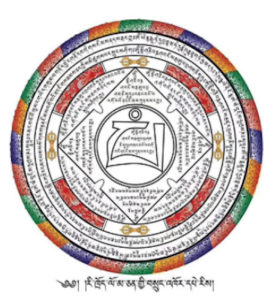Parnashavari Meditation Practice
Download the Parnashavari text
Parnashavari Sadhana
from the Collected Works of Jigten Sumgon
Download Parnashavari Sadhana (text)
In Buddhism we think of healing, ultimately, as a peaceful mind filled with love. We have many practices and visualizations to help us embody that realization. In Tibetan Buddhism we cultivate the awareness of perfected states of realization by using sound, imagery and imagination. By using these elements in meditation we are able to begin to experience the embodiment of compassion and insight.
There are a great many ways that compassion can express itself. In Tibetan Buddhism these expressions of compassion are represented and embodied by various deities and deity practices. It is sometimes explained that this is similar to light passing through a crystal lens, becoming a multicolored rainbow reflection, or many images to inspire devotion for different kinds of minds.
Within the family of Buddhas that emphasize how to learn compassion, there are famously 21 Taras, female Buddhas. Lady Parnashavari, the dakini who is attired in green leaves of medicinal plants, is the 20th of the 21 Taras. She protects us from contagious diseases such as the Coronavirus that we have today. I find her image compelling, as unlike most deities, who are depicted in royal attire, she is clothed in medicinal plants and herbs. She carries a bow and arrow and battle axe to vanquish illness (ignorance) and medicinal plants. She sits with one leg extended, ready to jump into action, an ancient super-hero! The significance is to cultivate confidence in our own seed of wisdom and that of others by imagining a powerful accomplished example.
Chanting mantra unites our body, speech and mind with her realization. We visualize her and all Buddhas filling the whole of space and sending healing nectar, filling the bodies of all sentient beings in every region and nation, all the bodies of water, all the vast extent of the skies.
To find this important practice, the head of our Drikung Lineage, HH Tinle Lundup, searched the ancient texts written by our founder, Lord Jigten Sumgon to find her practices so we could envision her now. He then composed this brief version.
Mantra:
OM PI-SHA-TSI PARNA-SHA-WARI SARVA MA-RI PRA-SHA-MA-NI HUNG
”Parnashavari


Full Practice
This is her mandala. The seed syllable “PAM” in the center, is the sound of her compassion. The mandala can be printed and hung in windows or gardens as a prayer flag, with the air carring the sound of compassion and her blessings to all countries.
Here is a teaching on the mantra:
OM: sacred syllable that consists of three sounds A, O and M, representing Buddha’s purified body, speech and mind. Here in particular, the sounds are invoked to prevent, protect and liberate our body, speech and mind from the epidemic disease such as the coronavirus.
PISHATSI: a female divinity of great powers such as a dakini or yogini who can protect, prevent and liberate beings from all negative and obstructing forces
PARNA: a leaf of a tree or a plant
SHAWARI: a tribal lady of the forest who masters magic and healing using forest herbs and medicines.
PISHATSI PARNASHAWARI: a powerful dakini who attired in green leaves of medical plants that are remedies to all illnesses and pestilences
SARVA: all, everything
MARI: illness or pestilence
PRASHAMANI: pacifier
SARVA MARI PRASHAMANI: the Pacifier of all illnesses and pestilences
HUNG: to attain the siddhis (attainment), to fulfill the aspiration, to be established in the deity-state, the Parnashavari-hood.
The head of our Drikung Lineage, HH Tinle Lundup, searched the ancient texts written by our founder, Lord Jigten Sumgon to find her practices so we could envision her now. He then composed this brief version.
